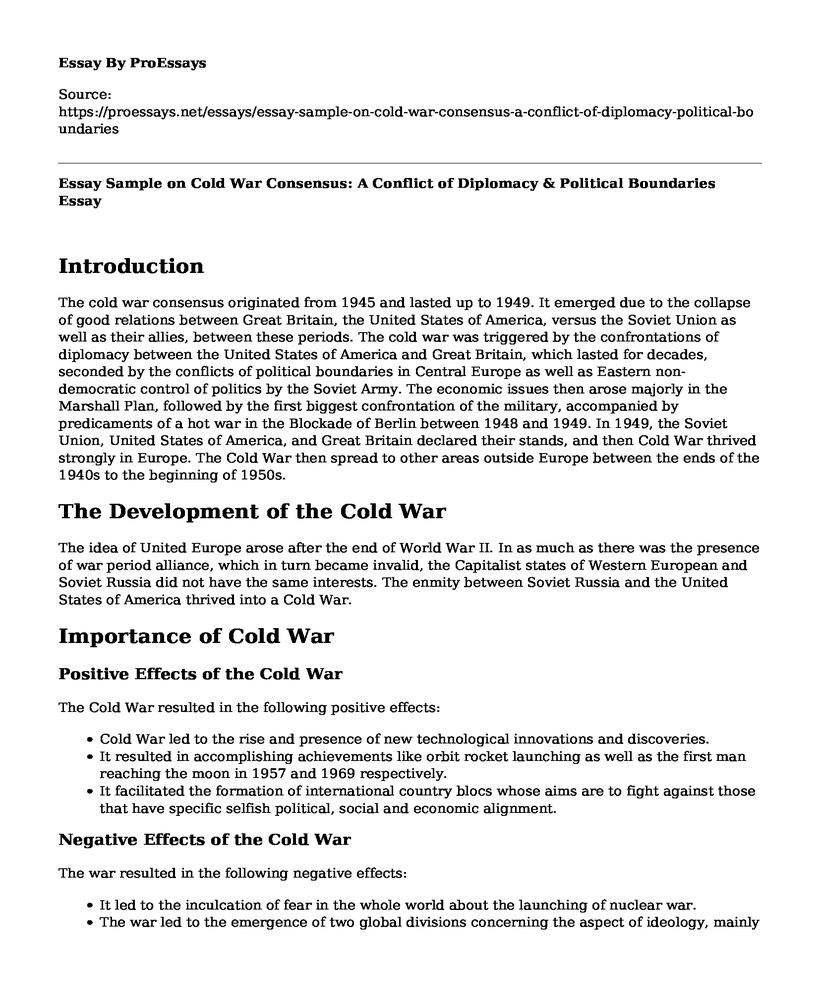Introduction
The cold war consensus originated from 1945 and lasted up to 1949. It emerged due to the collapse of good relations between Great Britain, the United States of America, versus the Soviet Union as well as their allies, between these periods. The cold war was triggered by the confrontations of diplomacy between the United States of America and Great Britain, which lasted for decades, seconded by the conflicts of political boundaries in Central Europe as well as Eastern non-democratic control of politics by the Soviet Army. The economic issues then arose majorly in the Marshall Plan, followed by the first biggest confrontation of the military, accompanied by predicaments of a hot war in the Blockade of Berlin between 1948 and 1949. In 1949, the Soviet Union, United States of America, and Great Britain declared their stands, and then Cold War thrived strongly in Europe. The Cold War then spread to other areas outside Europe between the ends of the 1940s to the beginning of 1950s.
The Development of the Cold War
The idea of United Europe arose after the end of World War II. In as much as there was the presence of war period alliance, which in turn became invalid, the Capitalist states of Western European and Soviet Russia did not have the same interests. The enmity between Soviet Russia and the United States of America thrived into a Cold War.
Importance of Cold War
Positive Effects of the Cold War
The Cold War resulted in the following positive effects:
- Cold War led to the rise and presence of new technological innovations and discoveries.
- It resulted in accomplishing achievements like orbit rocket launching as well as the first man reaching the moon in 1957 and 1969 respectively.
- It facilitated the formation of international country blocs whose aims are to fight against those that have specific selfish political, social and economic alignment.
Negative Effects of the Cold War
The war resulted in the following negative effects:
- It led to the inculcation of fear in the whole world about the launching of nuclear war.
- The war led to the emergence of two global divisions concerning the aspect of ideology, mainly the non-communist and communist.
The Collapse of the Cold War
The Cold War faced the following effects that led to its end:
The United States of America complied to the issue of complying with the military wish of offering their Army into the war of ensuring a free world in the sense of national security.
Cite this page
Essay Sample on Cold War Consensus: A Conflict of Diplomacy & Political Boundaries. (2023, Jan 11). Retrieved from https://proessays.net/essays/essay-sample-on-cold-war-consensus-a-conflict-of-diplomacy-political-boundaries
If you are the original author of this essay and no longer wish to have it published on the ProEssays website, please click below to request its removal:
- Proposed Policy Changes on Philippine Health Care System - Paper Example
- What Contributed to Americans Wanting to Rebel From British Rule? Essay
- Critical Essay on Sandor Marai's Embers
- Research Paper on Wilmington, NC: History, Beauty, and Splendor
- The Importance of Jazz Music During the Nazi Rule
- Essay Sample on St. Augustine: Medieval Philosopher, Theologian & Influencer of Western Christianity
- Research Paper on Dark Side of the Chocolate Industry: Child Slavery in West Africa







